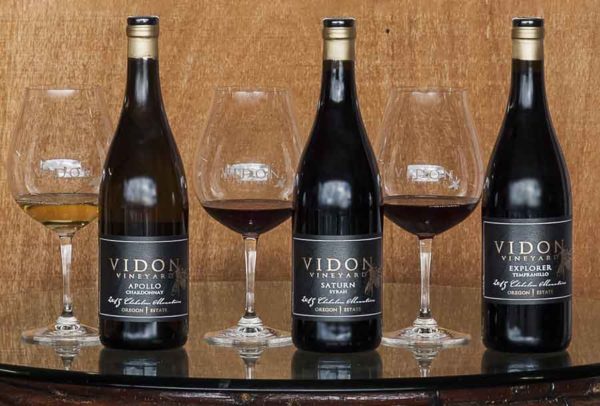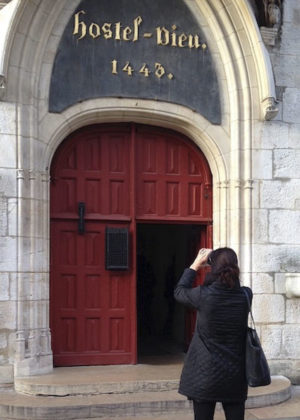Ever hear that phrase, “Who do you think you are? A rocket scientist?” Well, today’s guest IS a rocket scientist. One part humble Midwestern farm boy, one part retired NASA astrophysicist-turned-winemaker, Don Hagge of Vidon Vineyard (vee-dohn) talks softly and drives a big tractor. And at age 85, instead of slowing down, Don shoots for the moon – including a recent new release of his estate wines based upon NASA’s iconic space program, as well as implementation of a proprietary argon wine preservation tap system in his tasting room.
Recently, I caught up with Don to chat about life on his petite vineyard and boutique winery in Oregon’s Chehalem Mountain AVA in Willamette Valley.
LM Archer: You’ve been described as a physicist, farmer, winemaker and innovator. What aspect(s) of your role as physicist helped prepare for your current role as farmer/winemaker? What motivates you to take the road less travelled as an innovator?
Don Hagge: Since I grew up on a farm, the vineyard side is pretty much hard-wired. The scientific approach and methodology, ingrained as an experimental physicist, is helpful in the winemaking process.
While I’m not UC Davis trained, I don’t think it’s hurt me as a winemaker. I do things differently – I think I’m more systematic and organized. I’m always trying to understand what’s going on and why.

You arrived to winemaking at an age most people are ‘retiring.’ In your physics career, Ernest Lawrence figures prominently as a mentor, both academically and professionally. Any such figures in winemaking that have helped or inspired you?
Laurent Montalieu of Northwest Wines is the first winemaker I worked with, but many wine makers in the local community have been inspirational.
I think the land really inspires me. I fell in love with the land while doing tech work in Oregon, riding my bike through the Willamette Valley on weekends.
I would stop to taste wines from the area, and ended up talking to a lot of local wine makers like Lynn Penner-Ash, who was at Rex Hill at the time. I really liked Rex Hill wines, and found out that they got some of their fruit from Jacob-Hart Vineyard on Chehalem Ridge. So when I was thinking of buying this land on Chehalem Moutains AVA, I told Lynn – she got really excited, and even asked me to keep her in mind if I ever had fruit to sell, because she was just about to start out on her own.

Talk about the innovations you’ve made as an artisan winemaker, such as implementing your own glass stopper bottling machine – anything else you’ve ‘tinkered with’ to improve production? Do your colleagues ever come to you for help with their stuff?
My approach to winemaking is to constantly search for ways to improve efficiency in making the best possible wine from available grapes. For example, argon is used for oxygen management; which is superior to nitrogen.
Occasionally I get questions from winemaker friends about how and why I do certain things. They don’t always agree with me, but that doesn’t prevent me from trying it anyway. If you haven’t made any mistakes in life, you haven’t done much.
You purchased the land for what is now Vidon Vineyards in 1999, and built your home there in 2003. In 2014, Vidon Vineyard became 100% estate-grown fruit. You’ve invested not just toil, but time and treasure ensuring LIVE and Salmon-Safe certification. What sustained you during this painstaking route towards sustainability and self-sufficiency? It’s quite a commitment.
The goal was always to make great wine from this land I purchased. This required continuous learning and improvement in both the viticulture and winemaking aspects. Although I now get a lot of satisfaction from sipping my wines, I know they could be better.

Your vineyard boasts three soil types (Jory, Nekia and Willakenzie), southern exposures, and elevations ~400-500 ft (120-150 meters). You’ve planted your 12.5 acres (about 5 hectares) accordingly, with seven different varieties, including not just chardonnay, pinot blanc, pinot gris, and pinot noir (pommard, 115, and 777), but also syrah, tempranillo, and viognier.
How do you approach blending and bottling to yield the flavor profiles you seek in the finished wine, with so many flavor profiles at play?
Since all my pinot noir blocks are on Jory soil, the differences for each vintage is only because of the clones. My 3-Clones is a blend of 1/3 each of the single clones +/- 5% with 11 months in French oak. My Single Clones are not blended and are aged 18 months in oak. I don’t blend the other varieties except for co-fermenting 3-5% Viognier with Syrah.
As a farmer/physicist, what about each of these varietals alternately excites/frustrates you?
Pinot noir is a finicky grape and it’s difficult to keep the alcohol below 14% without watering – which I don’t do.
Even though pinot noir is supposed to be finicky, I think I’ve been pretty lucky, because since I started growing it, I’ve never really had a ‘bad’ year working with it. I’ve never found it to be a whole lot different from other varietals. I don’t do anything differently with it.
The main thing is to be meticulous and be clean, and to keep the oxygen out – I am adamant about that. And go back to the vineyard – if you make sure you have micronutrients in the soil, if you treat your soils right, then you won’t have problems inside with fermentation, etc.

You enjoy the good fortune of enlisting Adelsheim’s Chad Vargas to handle the vineyard labor and spraying, while you ride tractor for mowing and tilling. Can you tell readers a bit about that dynamic?
David Adelsheim is a neighbor and a good friend. When I started my vineyard, Chad Vargas offered to work with me because they bring in contract crews, so he started handling the labor part. Now they spray, till and mow for me, too. This year Chad is starting his own company, and he’ll continue to manage the vineyard and provide his services. I still like to drive the tractor in spring, though.
Oregon will always have many small vineyards and wineries which is what makes it neighborly. We need and depend on each other in several ways. We work together to create great Oregon wines that are competitive in the larger market.
What’s next on your agenda for Vidon Vineyard? Do you ever foresee increasing your current ~2000 case yearly production levels?
Not above what the vineyard will produce which is between 2000 and 2500 cases. Estate planning at my age is next!
What excites you most about your wine?
I can tell you about my own experience – a very specific one. In 2004, I was at lunch with a friend in Palo Alto, sipping a wine of mine that the restaurant carried, and tasting it brought me back to Burgundy – a bit lighter, a bit of barnyard.
I really love France – I really liked it while I was there while doing post-graduate research. I will never forget that feeling drinking that 2004 wine of mine – taking me back to a place I love. It was just really special.

Anything else you’d care to share with readers about Vidon Vineyard?
It has been a great journey! We started with a piece of land covered with stumps, rocks, scrub trees, poison oak and blackberries and turned it into a Boutique Winery on a Petite Vineyard that produces great wines.
Finally, if your experience as a vineyard owner and winemaker has taught you anything, it’s taught you…?
Care for the land and it’ll yield good fruit from which great wine can be made!
More on the vineyard: www.vidonvineyard.com
Photography: © Copyright Paul Cunningham, used with permission.
LM Archer is a freelance writer based in Seattle and California. She is Francophile who considers wine an art and Burgundy the centre of the universe. She is the founder and editor of binNotes | redThread.












One Response
What an amazing life Don Hagge is living. He is indeed one of those lucky individuals who set and succeed in fulfilling their disparate goals. NASA scientist and then a winemaker! I mean wow! It was such an interesting interview to read and also very inspirational. Being a wine lover, I also wish to become a winemaker myself someday. Although I always doubted if that would ever be possible, but seeing Mr. Hagg, it now appears that nothing in this world is truly impossible if you have the courage to achieve it. :) Thanks a lot for sharing such an informative and valuable insights on Vidon Vineyard.